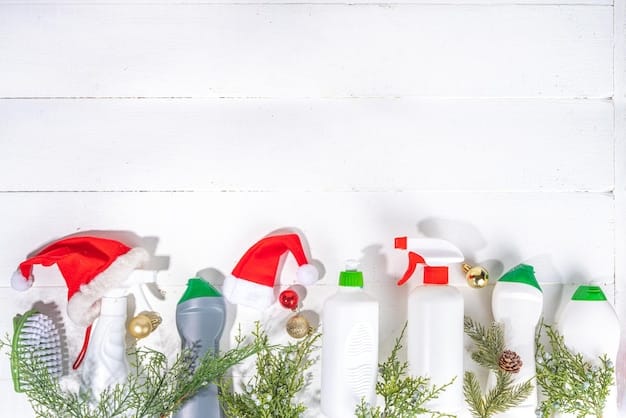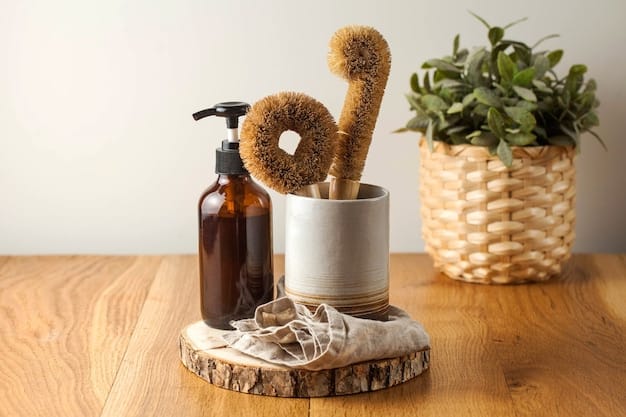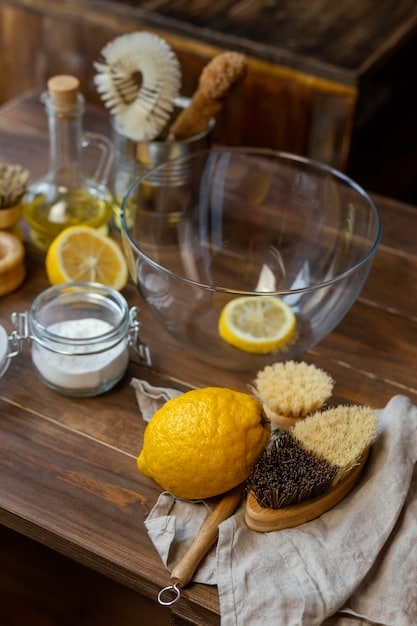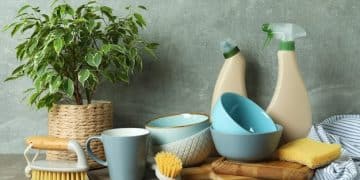Eco-Friendly Cleaning Products: Your Non-Toxic Guide

Eco-friendly cleaning products offer a safer alternative to conventional cleaners by reducing exposure to harsh chemicals, minimizing environmental impact through biodegradable ingredients and sustainable packaging, and promoting healthier indoor air quality for you and your family.
Are you looking to make your home a safer and healthier space? Switching to eco-friendly cleaning products is a simple yet impactful step towards a sustainable lifestyle. This guide explores non-toxic cleaning alternatives that are effective and environmentally responsible.
Why Choose Eco-Friendly Cleaning Products?
Conventional cleaning products often contain harsh chemicals that can harm your health and the environment. These chemicals can contribute to indoor air pollution, irritate your skin and respiratory system, and even have long-term health consequences. By choosing eco-friendly alternatives, you can minimize these risks and create a healthier home.
Healthier Home Environment
Eco-friendly cleaning products are formulated without many of the harsh chemicals found in conventional cleaners. This means less exposure to substances that can trigger allergies, asthma, and other respiratory issues. They reduce harmful VOCs (volatile organic compounds) released into the air, improving indoor air quality.
Reduced Environmental Impact
These products often use biodegradable ingredients and sustainable packaging. They help reduce water pollution by avoiding chemicals that harm aquatic life. They support companies committed to ethical and environmentally responsible production practices.

- Minimize Chemical Exposure
- Protect Water Sources
- Support Sustainable Practices
Making the switch to eco-friendly cleaning products aligns with a broader commitment to environmental stewardship. You’re not just cleaning your home; you’re contributing to a healthier planet for future generations.
Understanding Common Harmful Chemicals
многих очищающих средствах содержатся вредные химические вещества, которые могут нанести вред вашему здоровью и окружающей среде. Знание этих химических веществ поможет вам принимать обоснованные решения и избегать их при переходе на экологически чистые альтернативы.
Phthalates
Phthalates are often found in fragranced cleaning products. They are endocrine disruptors, which means they can interfere with hormonal balance. They are linked to reproductive and developmental issues.
Ammonia
Ammonia is a powerful cleaning agent but can cause respiratory irritation. It should never be mixed with bleach, as the combination creates toxic fumes. Exposure to high concentrations can burn the eyes, skin, and respiratory tract.
Identifying and avoiding these common harmful chemicals is a key step in embracing a healthier and more sustainable cleaning routine. Prioritizing products that are transparent about their ingredients and free from these harmful substances can make a positive impact on both your health and the environment.
DIY Eco-Friendly Cleaning Solutions
Creating your own eco-friendly cleaning solutions is a simple and cost-effective way to reduce your environmental impact and control the ingredients you use. Homemade cleaners are often just as effective as store-bought alternatives and require only a few basic ingredients.

All-Purpose Cleaner
Mix equal parts white vinegar and water in a spray bottle. Add a few drops of essential oil, such as lemon or lavender, for fragrance. This solution is excellent for cleaning countertops, sinks, and other surfaces. Avoid using it on marble or granite, as the vinegar can etch these materials.
Glass Cleaner
Combine 1/4 cup white vinegar, 1/2 teaspoon liquid dish soap, and 2 cups of water in a spray bottle. Spray on glass surfaces and wipe clean with a microfiber cloth. For streak-free results, use a clean, dry cloth to buff the surface.
- Cost-Effective
- Customizable
- Reduces Waste
Embracing DIY cleaning solutions can be a fulfilling and sustainable practice. By using simple, readily available ingredients, you can create effective cleaners that are safe for your family and the environment.
Top Eco-Friendly Cleaning Product Brands
If DIY isn’t your thing, numerous brands specialize in eco-friendly cleaning products. These companies are committed to using sustainable ingredients and packaging, offering a variety of options to suit your cleaning needs. Look for certifications like EPA Safer Choice and Leaping Bunny to ensure the products meet environmental and ethical standards.
Method
Method offers a wide range of plant-based cleaning products in stylish, recyclable packaging. Their products are non-toxic, biodegradable, and cruelty-free. Method is also committed to reducing its carbon footprint through sustainable manufacturing processes.
Seventh Generation
Seventh Generation is a well-known brand that focuses on creating products that are safe for both people and the planet. Their product line includes everything from laundry detergent to household cleaners, all made with sustainable ingredients and packaged in recycled materials.
When choosing eco-friendly cleaning brands, it’s essential to evaluate their commitment to sustainability beyond just the ingredients they use. Consider factors like packaging materials, manufacturing processes, and certifications.
Tips for Sustainable Cleaning Practices
Adopting sustainable cleaning practices goes beyond just using eco-friendly products. It also involves rethinking your approach to cleaning and making small changes that can have a big impact. This includes using less product, opting for reusable tools, and properly disposing of waste.
Use Less Product
Often, we use more cleaning product than necessary. Follow the instructions on the label and use only the recommended amount. Overusing cleaning products not only wastes resources but can also leave behind residue that attracts dirt.
Opt for Reusable Tools
Replace disposable cleaning supplies with reusable alternatives. Use microfiber cloths instead of paper towels for cleaning surfaces. These cloths are highly absorbent, durable, and can be washed and reused multiple times. Switch to reusable sponges and mops to further reduce waste.
- Reduce Waste
- Save Money
- Conserve Resources
By integrating these sustainable cleaning practices into your routine, you can minimize your environmental impact and create a cleaner, healthier home. Every small change counts towards a more sustainable lifestyle.
Making the Switch: A Gradual Transition
Transitioning to eco-friendly cleaning doesn’t have to happen overnight. It can be a phased approach, starting with replacing one or two products at a time. This allows you to test different brands and DIY solutions to find what works best for you and your home.
Start with the Basics
Begin by replacing your most frequently used cleaning products, such as all-purpose cleaner, dish soap, and laundry detergent, with eco-friendly alternatives. These are often the products you use most often, so switching them first can have the biggest impact.
Read Labels Carefully
When purchasing eco-friendly cleaning products, take the time to read the labels carefully. Look for products that are certified by reputable organizations like EPA Safer Choice, EcoLogo, or Leaping Bunny. These certifications indicate that the products have been evaluated for their environmental and health impacts.
Embracing eco-friendly cleaning is a journey, not a destination. By taking a gradual, mindful approach, you can make sustainable cleaning practices a permanent part of your life.
| Key Point | Brief Description |
|---|---|
| 🌿 Healthier Home | Reduces exposure to harsh chemicals and improves indoor air quality. |
| 🌎 Lower Impact | Uses biodegradable ingredients and sustainable packaging to protect the environment. |
| 💰 DIY Solutions | Cost-effective homemade cleaners with natural ingredients like vinegar and baking soda. |
| ✅ Gradual Switch | Transitioning one product at a time allows you to discover the best solutions for your home. |
Frequently Asked Questions
▼
Yes, many eco-friendly cleaning products are highly effective. Look for products with certifications like EPA Safer Choice.
▼
Common ingredients include white vinegar, baking soda, essential oils, and plant-based surfactants.
▼
Yes, it’s easy to make your own with simple ingredients like vinegar and baking soda. Many recipes are available online.
▼
Some may be slightly more expensive, but DIY options can be very cost-effective. Brands often have affordable options.
▼
Look for certifications like EPA Safer Choice or EcoLogo, and check the ingredient list for harmful chemicals.
Conclusion
Switching to eco-friendly cleaning products is a beneficial choice for your health and the environment. By understanding the impact of conventional cleaners, exploring DIY solutions, and choosing reputable eco-friendly brands, you can create a cleaner, safer, and more sustainable home.





